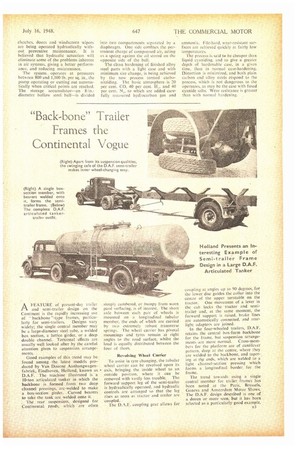Four Steered Wheels in
Page 52

Page 53

If you've noticed an error in this article please click here to report it so we can fix it.
New Leyland Six-wheeler THE manufacturing schedule of Leyland Motors, Ltd., Leyland, Lancs., for the present year includes a new forward-control goods six-wheeler, which embodies some unusual features. Unlike the conventional chassis of this type.the new machine, which is known as the TwinSteering Beaver, has four steered wheels at the front and a Single driven axle at the rear. It is designated the TEC1, and .fills the gap between the 71 and 12-tonners in the Leyland -range.
By adopting a layout of this kind, it has been possible to market the machine at a lower initial cost than the orthodox six-wheeler. The Twin-Steering Beaver will legally carry a gross load of 10f tons and, being designed as a heavy-duty machine with little overhang at the rear, it is equally 'suitable for regular trailer work, in which case an additional gross load of 61 tons can be hauled: Cood distribution gives a 7i-ton rear-axle loading, accompanied by excellent road adhesion.
Easy ma.nceuvrability is a feature of the new product and, as four of the six wheels are steered, bogie scrub, which is often associated with the conventional sixwheeler, is claimed to be entirely overcome, thus resulting in better fuel consumption and improved tyre wear.
In appearance and general design the new model is similar to the well-known Beaver range with six-cylindered engines, but it has a slightly longer wheelbase, a streugthened frame to deal with the additional load and, of necessity, a different braking layout, which is free front the complications sometimes to be found on six-wheeled machines. The foot brake operates,' through a vacuum servo mounted inside the frame, on all six wheels, whilst the hand brake takes effect on the centre and rear wheels. Fully enclosed 17-in, diameter drums Are used, the shoes in those at the front being 3 ins. wide.and in those at the rear 6 ins, wide.
Previous experience gained with the twin-steering arrangement on the Leyland Octopus has been used to good effect
in planning the steering on the new model, and it is both positive and light in action.
In common with all Leeland goods machines. either a petrol or oil power unit can be supplied, the bore and stroke dimensions of the former being 41 ins. and 51 ins., and of the latter 41 ins. and 51 ins. The rating of the petrol unit is 43.5 lep. and of the oiler 48.6 b.h.p. With a petrol engine installed, the net chassis weight conies out at 4 tons 8 cwt. and, with the oil engine, it is 4 tons 12 cwt. 2 qrs.
The wheelbase of the new machine is 17 ft. 3 ins., the turning circle being 62. It. The overallwidth of the chassis is 7 ft. 6 ins, and its length is. 23 ft., the standard body dimensions being 17 ft. 6 ins, long and 7 ft. 2 ins. wide. The same size tyres are fitted on all wheels (36-in. by 8-in.), twins being used on the rearmost wheels.
The chassis can be supplied. with worm or bevel final drive, two ratios for each type being marketed; the former are 7.33 or 6.5 to 1, and the latter 7.15 or 8.19 to I. A four-speetl-and-reverse .gearbox is used, the ratios being as ollow:--Top, direct; third, 1.73 to 1; second, 3 to I; first, 1.78 to 1; reverse, 5.57 to 1. clutches, doors and Windscreen wipers are being operated hydraulically without preventive maintenance. It is believed that hydraulic 'actuation will eliminate some of the problems inherent in air systems, giving a better performance. and reducing maintenance.
The system operates at pressures between 800 and 1,100 lb. per sq. in., the pump operating or cutting out automatically when critical points are reached. The storage accumulator—an 8-in.diameter hollow steel ball—is divided into two compartments separated by a diaphragm. 'One side confinee the permanent charge of compressed air, acting as a spring against the oil stored on the opposite side of the ball.
The clean hardening of finished alloy steel parts with a light case and with minimum size change, is being achieved by the new process termed carbonitriding, The basic atmosphereis 20 per cent. CO, 40 per cent. H„, and 40 per cent. N„ to which are added carefully teeeetired hydrocarbon gas and ammonia. File-hard, wear-resistant surfaces are achieved quickly at fairly low temperatures.
The process is said to be cheaper than liquid cyaniding, and to give a greater depth of harclenable case, in a given time, than in normal case-hardening. Distortion is minimized, and both plain carbon and alloy steels respond to the process, which is not dangerous to the operators, as may be the case with fused cyanide salts. Wear resistance is greater than with normal hardening. .




















































































